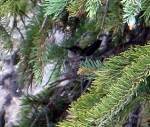
In 2003 two volunteer researchers conducted a survey of hummingbird species and populations in Rocky Mountain National Park. Both researchers held federal, state, and park permits to conduct the research. The initial survey focused on the Eastern Slope areas of Moraine Park and the Cow Creek drainage. The survey actions consisted of identifying habitat; capturing, banding, measuring, and releasing the birds; observing nest sites (click here to see large photo of hummingbird nest), when possible; and, developing information that could be useful in future years for monitoring the health of hummingbird populations in the park. At the completion of the year’s project a formal report was required to be submitted to Rocky Mountain National Park. 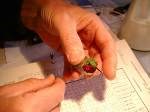
Over 300 broad-tailed, rufous, and calliope hummingbirds were banded by mid-July, and the volunteer researchers estimated that over twice that number would be banded by the end of the summer, thereby providing valuable data for use in understanding survivorship, site fidelity, reproductive success, health, and other useful information assuming the study is continued over the next several years. Each captured hummingbird was fitted with a small aluminum band approximately the diameter of the “O” in “One Cent” on the reverse side of a penny. The band, provided by the U.S. Geologic Service’s Bird Banding Laboratory in Laurel, Maryland was imprinted with a unique letter and five-digit number combination that relates to each bird’s “vital statistics.” (Click here for large picture.) These statistics included the date and time of capture, location of capture, mass, wing chord, and other useful measurements. Some of the hummingbirds were imaged with a digital camera to provide documentation for possible future use.
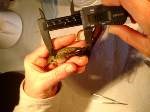
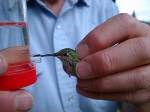
Once all measurements were made and recorded, each hummingbird was offered a sugar water solution to help compensate for missed feeding opportunity during the banding and measuring process. (Click here for large picture.) 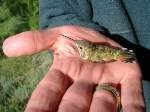
After a final check to ensure that the leg band was properly fitted, the researcher released the hummingbird. Hopefully it would be captured again by another researcher or found and reported to the Bird Banding Laboratory by the public. (Click here for a large picture.) This information is invaluable in understanding migration timing and routes and many other subjects thereby enabling humans to better understand these amazing birds and protect them in the future. Photos courtesy of Tena Engelmann |
Last updated: March 31, 2012
